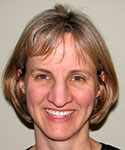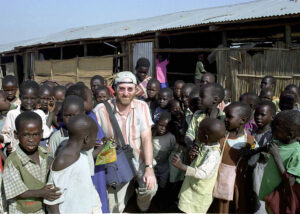Giving is about much more than money. What we do with our time, talent and treasure all matter to God. As Jesus said, “For where your treasure is, there your heart will be also” (Matthew 6:21,
Luke 12:34).
I am a doctoral student researching giving within the sustaining church bodies of Mennonite Foundation of Canada (MFC). I’m also a fundraising consultant and former pastor, and am passionate about both fundraising and theology. When I do donor research, I ask about money, but I’m even more interested in hearts. Generosity makes our hearts grow bigger, according to Growing Givers’ Hearts: Treating Fundraising as Ministry by Thomas Jeavons and Rebekah Burch Basinger; it strengthens discipleship, builds community and promotes unity.
In a typical year, church members in MFC’s constituency give more than $100 million to their local congregations, which is astonishing for a base of around 70,000 members. And that’s only receipted giving to churches. It doesn’t include the sponsored children, fundraisers for church camp, regular support for mission workers, gifts to local causes and much more. Nor does it include the thousands of volunteer hours and gifts of time and talent.
From May to December of last year, I met with groups of donors from B.C. to Ontario in order to learn more about how and why people give. With support from MFC, I held 10 focus groups with a total of 66 people.
It was humbling to meet so many generous people. The quotes are from real donors, but the characters I have created are composites and the identities are fictional. I want to talk about discipleship, community and unity, and after reading their stories I hope you will be inspired to join the Big Hearts Club too.
Discipleship
Being a regular and cheerful giver makes an excellent start on a journey of faithful stewardship. Sharing our stories along the way encourages us to “walk the talk,” which is what discipleship is about. Let me introduce two characters:
• Anne is analytical and her father-in-law Fred is free-spirited. Anne is the kind of donor who looks carefully at a charity’s financial statements, or checks it out on the Canada Revenue Agency website. She is very concerned with efficiency. If a charity advertises on TV, she wonders how much it costs to do that. Some of the charities her father-in-law supports Anne wouldn’t go near. She regularly and faithfully supports a small number of charities: her church, local agencies and trusted mission workers. She reviews the list every year.
• Fred gives more spontaneously than his daughter-in-law does. It might be to a missionary or to a Christian organization on TV. Unlike his daughter-in-law, he never looks at the financial reports. Once he gives to an organization, “they’re accountable to God for what happens to the money,” he says. Fred makes numerous one-time gifts to charities like the Heart and Stroke Foundation when asked. (He gets asked a lot.) Aside from his church, Fred’s giving patterns are unpredictable.
Anne and Fred could learn from each other, seeking “to do what is right, not only in the eyes of the Lord but also in the eyes of man” (II Corinthians 8:21). Fred could use some help with his planning. People who plan their giving generally give more in total. While Fred likes spontaneous Spirit-inspired giving, it’s also true that the Holy Spirit can work 12 months in advance, according to Edwin Friesen, who was an MFC stewardship consultant from 1995 until his death in 2008. Anne could learn from Fred’s example of being a “hilarious giver”
(II Corinthians 9:17), and perhaps create a budgeted amount for spontaneous giving.
Testimony and discussion encourage discipleship around giving. I enjoyed hearing people’s stories of how they learned to give, and how giving has changed their life:
• Cal—the faithful tither—learned tithing from his dad. Without fail, 10 percent of each paycheque went to the church. “It didn’t matter what we wouldn’t get [as a result of money going to the church instead of other things],” says Cal, not harshly but admiringly. Cal’s wife Linda remembers getting her allowance in dimes so she could easily tithe. Cal and Linda model regular giving to their four children, just as their parents did. They tithe faithfully to the church, support several sponsored children and give to other church-related causes when they can.
• Christine—the volunteer—works in her church office part-time and volunteers for a Christian children’s charity the rest of the week. She also recruits friends from church to volunteer. She donates regularly to both places. Christine cannot afford to be a big financial donor, but she is generous with her time and talents. If she could afford to stop working, she would like to take in foster children. Many people from her congregation donate to the charity where Christine volunteers because of her involvement.
• Janet—the God-tester—laughs and says, “You’ve can’t out-give God. It’s a little game we have.” She means you can always afford to be generous (II Corinthians 9:8). She is excited to talk about her giving: “You just see God working. So many people don’t see God working in that way because they don’t give him the chance. We run on a pretty tight budget and we make it through every month. . . . It almost seems like I have more money when I give it away.” Janet testifies that her husband became a Christian through their giving, and it’s clear that giving forms a big part of her faith.
• Keith—the theologian—is actually a mechanic. He would be surprised, and possibly insulted, to be called a theologian. He understands tithing, but is not legalistic. “Ten percent is a good number, but if you can give more, give more,” he says. “If you can only give 6, 7 percent, that’s okay.” When asked how he learned to give, Keith talks about God’s ownership, saying, “If you’re just pleasing yourself . . . it’s a lot harder to give because it feels like it’s your money. But if you approach it as if it’s God’s money, not mine, it’s a whole lot easier. It was never mine to begin with.” Keith understands that everything he has belongs to God, that people are stewards of what God has given to them.
• Joyce—the “bad banker”—is actually a retired banker. She jokes that her employer thought she was a “bad banker” because she counselled clients to take off their giving first, then their payments, and then live on the rest. She used to be a church treasurer too, a few years back. Joyce and her husband have been faithful donors all their lives, and by now their list of causes is well-established. Joyce has quietly taught her children how to give. She would be the ideal person to assist in premarital counselling and to help people in her congregation who are experiencing a financial crisis.
• Richard—the non-giver—is someone I never actually met, but I met people who knew him. His church never talked about giving. Richard never heard the expectations about giving that come with membership because those expectations were unspoken. And he didn’t learn about giving at home, like Cal did. Richard has a mortgage and a car loan, and owes money on his credit card. His church does not thank him when he does give, nor does it seem to notice if he goes six months without putting anything in the offering plate. The only difference Richard observes is whether or not he gets a tax receipt from the church at the end of the year.
Richard represents a missed opportunity for encouraging discipleship. Wouldn’t it be wonderful if Richard and Joyce could go out for coffee? They could have a great discussion about God’s ownership, first-fruits giving and how to develop habits of regular giving. It would strengthen discipleship and build a stronger community of faith.
Community
The discipline of giving strengthens a community of faith, and giving to a common cause strengthens it further. However, one cannot assume that people from the same area church give to common causes. My small sample of 66 donors gives to more than 200 different causes, which suggests tremendous diversity. I frequently quote the donor who said, “My parents raised me to be an atheist,” as a reminder not to presume a common background, such as one where people naturally grow up knowing about Mennonite Central Committee (MCC).
The reasons people give are also diverse. “To help a cause I believe in,” was the top response from MFC constituents by a wide margin, while getting a tax receipt was at the bottom of the list of reasons for giving.
I also found evidence of a generational shift towards giving to a variety of causes beyond Christian circles:
• Albert—the missionary parent—supports missionary children based in the Philippines. If you saw Albert at Tim Horton’s, you wouldn’t realize that he is a major supporter of an overseas mission station. His daughter married a Filipino, and they run a base for mission workers in the area. Churches, as well as area and national church offices, support mission workers, but families support them in a more involved way. Albert gives to the church, but doesn’t have to think about where the rest of his giving goes.
• Stella—overwhelmed by choices—finds deciding where to give is much more difficult than it is for Albert. There are so many good causes! Some choices are easy: the church, of course, and the woman undergoing medical treatment who is being supported by the congregation. Stella gives to local families in need, or to youths going on a mission trip or to Bible camp. But the Compassion and World Vision Christmas catalogues come on the same day. And then Samaritan’s Purse and Gospel for Asia both do something along the same lines. People come to her door asking for donations. Stella gives to the causes that are most familiar, but she struggles with the constant decision-making. “How do you decide?” is a question I heard over and over again, and not just from Stella.
Unity
Albert and Stella both need the community of faith to help them. Common causes build unity. The church could help Stella choose causes that are aligned with the mission of the church. The church could help Albert build a broader base of support for the mission station where his daughter lives. Conversely, when a community gives and works toward a common purpose, it becomes more unified.
Giving becomes community-building when we give “to help a cause we believe in.” Giving becomes unity-building when multiple communities give together. Agatha’s story illustrates this:
• Agatha—the area church
loyalist—says of the decline in giving to her denomination, “We are very strong conference people, and it hurts us.” Without the assistance of MCC and the denomination in helping them settle in Canada after the war, she wonders what would have become of her and her husband? Their loyalty and gratitude to MCC and the wider church are unbounded. “Some of it is payback,” her husband explains. They are saddened that younger generations do not give in the same way to these causes, but younger people are not well represented in the church Agatha attends.
• Brian—the new kid on the block—gives to the same camp that Agatha supports, but other than that they have no common causes. He doesn’t have any history with the Mennonite church. As a child, he attended a Catholic church sporadically, and his wife has no church background. They attend a local, recently planted Mennonite church, where they enjoy the worship and the friendly people. The church connects well to the community. Brian does not know what an area church is. It doesn’t really matter to him or to his congregation. Brian’s giving connections are to the local congregation, the mission workers who share testimonies there and to the church camp where he volunteers in the summer.
According to my survey, after the local church and mission workers, children’s causes such as child sponsorship and camp are the most frequent regularly supported causes. Brian is a typical donor. His giving pretty much stops where his community stops, as he is largely unaware of any bigger connections.
In conclusion
In my survey, I asked people which area church they belonged to. A couple of people didn’t know and one brave person asked what that was. While most people did check the appropriate box, many didn’t really know what their area or national church did.
Not surprisingly, then, survey results show more trust in the local church than in the wider church bodies. The Muttart Foundation study, from which I borrowed the question, found something similar: People trust their church more than they trust a religious organization. The local church feels closer.
While there are exceptions, it seems that MFC’s constituent congregations have no difficulty funding projects that are meaningful to them. I saw new buildings and heard numerous stories about youth mission trips. These tangible, visible projects build local community, but each church can be headed in a different direction.
While the local church remains the charity of choice, my survey results show a “gratitude gap.” The local church and Christian organizations do not thank donors nearly as often as secular organizations do.
What does it say about our theology if the church doesn’t celebrate the gifts of time, talent and treasure that it receives? Saying “thank you” acknowledges gifts the church has received from God through member giving. The local congregation could start by intentionally thanking volunteers and donors. Thank the donors and tell them what their gift will accomplish (II Corinthians 9:12). Make it easy for donors to plan their giving and give on a regular basis (I Corinthians 16:1-2). It’s not just about money, but about growing disciples, building community and promoting the unity of the church.
In closing, I want to promote the MFC. Its consultants do a fantastic job of working with congregations and individuals to promote “faithful joyful giving.” Ask if someone can come speak at your church. Instead of thinking of it as someone coming to talk about money, consider it as an invitation to make your hearts grow bigger.
Lori Guenther Reesor of Mississauga, Ont., is completing her doctor of ministry studies at Tyndale University College and Seminary, Toronto, and then looking to expand her fundraising consulting practice. She attends Hamilton Mennonite Church with her husband and two teenage children.








Leave a Reply
You must be logged in to post a comment.